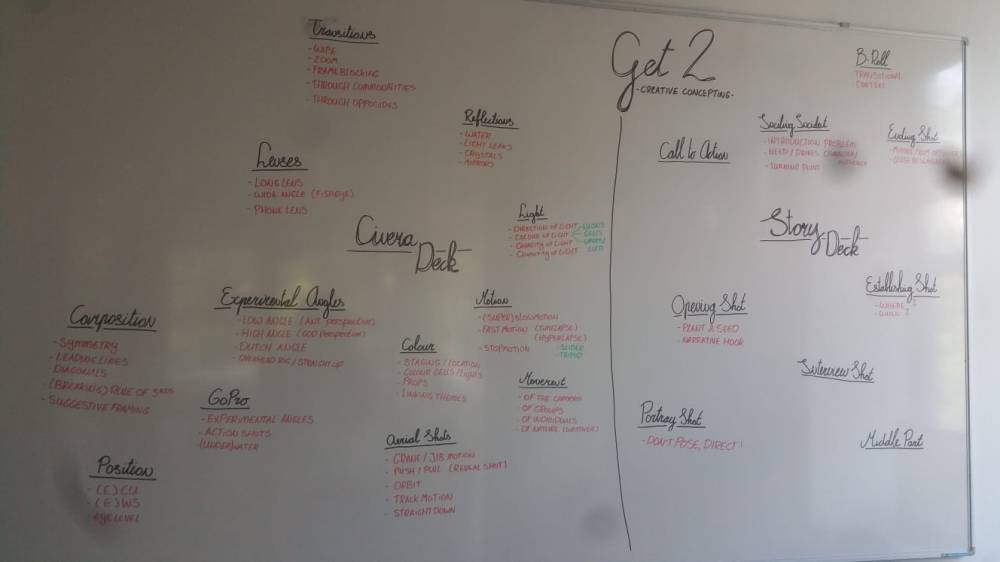The previous 2 chapters of this report focused on storytelling and visual mystique studied from a more abstract, fundamental perspective. This chapter will focus on more practical means of applying narrative and visual techniques in low-end productions by looking at the challenges of conventional methods and transforming those to opportunities.
3.1 Challenges
3.1.1. Chapter 1 | No time for Visual Complexity
When working low-end it is easy to overlook the creative opportunities an image brings with. Especially when working as a one-man band the prioritising focus will always be on getting the technicalities right. However, considering the creative aspect of perhaps just a few shots in the production can make the absolute difference between another corporate video and an unique style and mood.
Such an unique mood is attributed through visual meaning; using a visual technique not just because it looks good but because it adds to the story of the video/and or client. Figuring out which visual technique to apply for what cause, however, costs time and practice. Two resources which are a rarity out at Low-End productions. What we need, is a quick, creative solution.
3.1.2. Chapter 2 | The value of narrative structure is often underestimated
Story structure and story components are essential building blocks for hooking the audience and getting a message across. In low-end, non-fiction productions there is often a tendency to overlook these elements; simply documenting an event or story without thinking of a structural approach beforehand. This translates to a lot of (unusable, unfocused) footage as well as much lost time in the post production process (spotting footage, crafting a story which makes sense).
Applying narrative components to a production script should become a deeply rooted habit during the preparation phase of any film outing.
3.2 The 1Camera Mission & Creative Solutions
The branding of 1Camera evolves around their cinematic, silver-screen quality and emotion-driven potential. To raise these quality stakes in the lower-end, corporate and non-fiction productions, story-structure and visual language have to be considered more thoroughly. However, these techniques demand a more labour-intensive pre-production stage, asking for more time thus money. Even though lost time in pre-production will most likely be counterbalanced through a more focused production and post-production approach, there should be means for implementing story structure and visual language in a more routine set of actions; translating creative concepting to an applicable product.
The most thought-consuming part of these additional stakes which have to be considered is to map and identify which cinematic language and narrative structure is needed for the product at hand. I turned to popular design techniques to find inspiration for how to ease this research- and thought- consuming decision process. Looking for the most ‘quick and dirty’ techniques to simplify conceptual trap-hazards.
Indian Designer Shibu Pingme creates brand icons by combining two elements; creating thoughtful, minimalistic and consistent pursued images as seen below:
Retrieved from Behance.
Pingme’s technique of combining contrasting efforts made it easier to generate ideas. This technique became the fundamental idea for my product. To chunk difficult studies to a simple tittle card, to then combine a card categorised ‘Visual Language’ with a ‘Story Components’ card in a simple sum, to make the generating of ideas less widespread and labour-intensive but easy and minimalistic.
3.3 Chunking & Simplicity
Pingme’s technique is so highly effective because it presents two simple starting points: a simple image matched with another simple image forming a more intricate shape together. Note how this feels similar to our 1st challenge from chapter 3.1, we need to match visual features with meaning and story.
3.3.1 Chunking Chapter 1 | Visual Methods
I applied Pingme’s technique to my conduct by grouping the collected information from the 1st chapter and 2nd chapter on visual techniques to sweet and simple means. Dissecting the 4 key features to 11 applicable style choices, all achievable with current 1Camera equipment or small purchases.

3.3.2 Chunking Chapter 2 | Narrative Components
The narrative study pointed out the importance of a clear intention (in the shape of fundamental tendencies) as well as the need for story structure and scenes. I decided to dive deeper into the application of story structure to simplify and chunk the narrative information to practical playable cards.
Each link below leads to a small page about the described Story Component. Why the component is vital, how the component is applied and what opportunities the application of mentioned components awakens. All components together make for a structured story.
ACT I*
ACT II*
- The B-Roll
- The Interview Shot
- The Middle Part
ACT III*
*The components are also linked in the side tab below the main menu.
– Summing-up Sub-Question 3 –
Can the discovered techniques be applied (or made applicable) in a Low-End production?
The discovered techniques are often left untouched in the Low-End field due to lack of time for visual complexity, and misunderstanding about the value of narrative structure. However, visual complexity is an actual fundamental of the 1Camera mission and the addition of narrative components can save a lot of expensive post-production hours.
The most thought and time consuming part of applying new techniques is the decision making part of which techniques have to be considered. To map and identify which cinematic language and narrative structure is needed for the product at hand.
However, through quick and dirty match-making techniques this element of the ‘which option to choose’ can be decided for the producer. With elaborate research packed, chunked and simplified to 9 Story techniques and 11 Visual techniques, the discovered techniques become more applicable, even in the Low-End field.